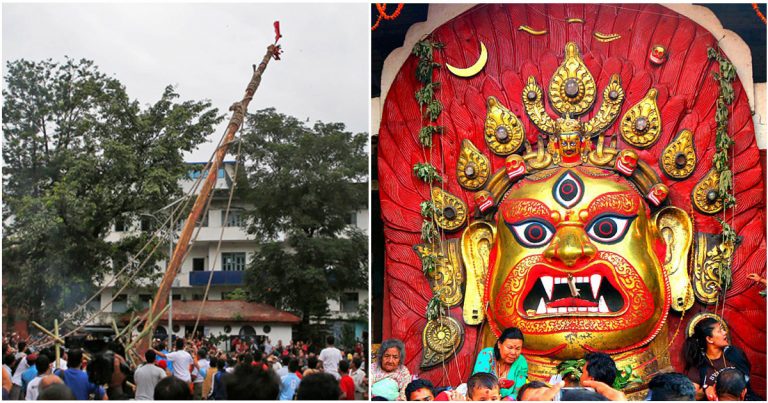
The origin of Indra Jatra:
Legend has it that Basundhara, the mother of Lord Indra (or Dagin in Nepali Bhasa) wanted Parijat (Night Jasmine for a compulsory ritual in heaven. Lord Indra descended to Kathmandu disguised as a local in search of Parijat. During the act of collecting the flower the locals caught and mistook Lord Indra for a thief. Hands tied he was then put on public display upon a raised platform.
As time passed and worry took over, mother Dagin herself descended to Kathmandu. When asking for the release of her son, the people asked something in return. For this, Dagin (or Basundhara) introduced herself and her son with an assurance of fog and dew to facilitate better (paddy) crops. It is believed that due to this boon, Kathmandu starts to be foggy right after Indra Jatra as coldness enters the valley with the accompaniment of dew. Today, the place Lord Indra was captured is called “IndraChowk” – meaning the crossroad (chowk) of Indra. The detention incident is replayed in several ways at various toles(junctions) across Kathmandu
The festival also marks the arrival of autumn in Kathmandu Valley, and is a part of a much more elaborate celebration.
Here are a few facts on the festival:
Yain Yah (Nepali Bhasa) literally means The Festival of Kathmandu (Yain – Kathmandu, Yah = festival).
The event kicks off with the raising of 108 hands long (equivalent to 108 feet) IndraDhoj (Flag of lord Indra). It is believed to be one of the oldest existing flags in the world – the symbol of an autonomous country.
Yain Yah begins from YawnLaThwoDwa-dasi or the 12thday of Full Moon in September. An oil lamp is lit on a pole at Indra Chwok. It is an offering of light to the heavenly bodies that pass by. The locals call it “Aalo (k) Mata” (Light of another world) – many such lamps can be seen in the houses of locals too.
During these eight days, dances reflecting various deities and ethnicity/culture groups are performed throughout the valley. Amongst them, the Matrika dance (originally from Bhaktapur) is of great significance.
Kumari (The Living Goddess) is taken out of her official residence only once a year – during IndraJatra. Kumari is shown in pure red color with a peacock as her vehicle/bahan.
Historically, the chariot procession of Kumari was introduced by Jaya PrakashMalla, the last king of Malla dynasty in Kathmandu(1736 to 1746 and again from 1750 until his death in 1768 AD). The myth says he did this to prolong his rule.
At the onset of this festival, huge masks of Bhairab are on once-in-a-year public display until the festival ends. Among them the biggest one is of Sweta Bhairab at Hanuman Dhoka .
In the entirety of the eight days, a silent play called DasAvatar is shown at the steps of a temple just in front of Kumari Chen. This is a show for the Kumari which begins only after her arrival. She watches the play from the golden window at her official residence. One is not allowed to look into the window.





